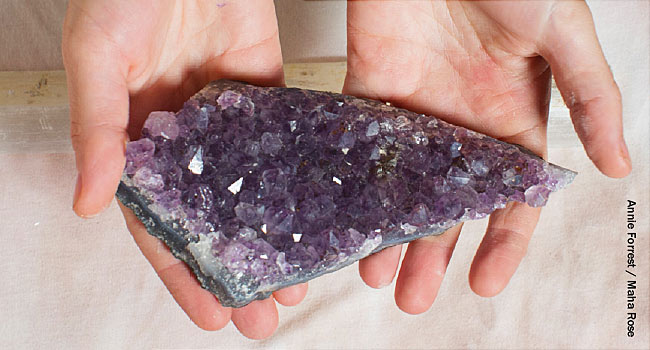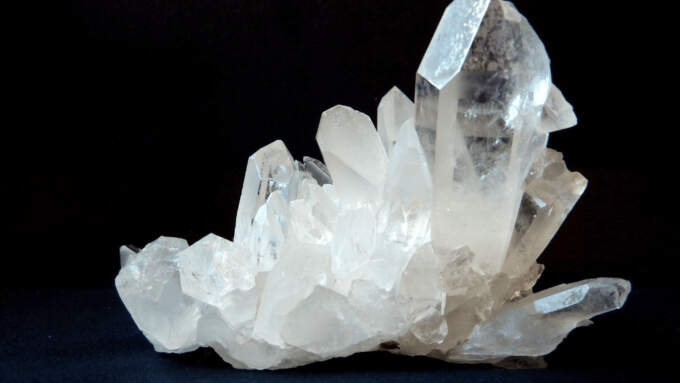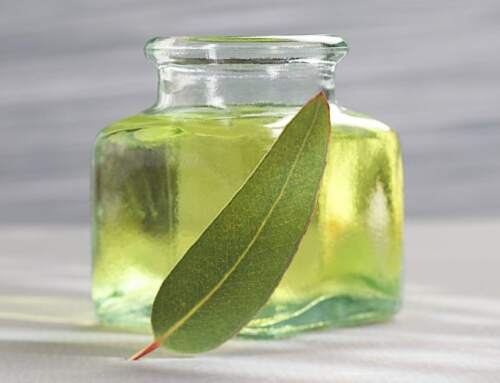Crystals, with their dazzling appearance and unique properties, have been a subject of fascination for centuries. These solid materials are not just beautiful stones with high aesthetic value; they have been revered for their supposed healing powers and have played a significant role in various cultures. Historically, crystals like amethyst have been incorporated into jewelry such as crystal bracelets, and many believe in the concept of crystal healing, attributing the ability to balance energy fields to these stunning structures.

One of the most captivating aspects of crystals is their organized cellular structure, forming intricate and symmetrical crystal structures. This structure is what gives each type of crystal its distinctive appearance and properties. For instance, liquid crystals are used in many display screens due to their unique ability to respond to electrical currents, while gypsum crystals are known for their use in construction materials like drywall.
In the pursuit of unraveling interesting facts about crystals, renowned institutions like New York University and Purdue University have conducted extensive research on crystal growth and the formation of the largest crystals known to man. Their studies delve into the myriad of crystals available, from common citrine crystals to rare and valuable diamonds, each with its unique set of characteristics.
Whether you are drawn to crystals for their aesthetic appeal, intrigued by their unique properties, or interested in exploring their healing powers, the world of crystals offers a wealth of knowledge and beauty waiting to be discovered. So, let’s embark on a journey to explore the enchanting realm of crystals and uncover the mysteries behind each beautiful stone.
Unraveling the Mysteries of Crystals
Crystals, with their mesmerizing structures and diverse forms, are nature’s wonders that have intrigued minds for centuries. But what exactly are crystals? They are meticulously ordered structures, where atoms are arranged in a precise repeating pattern, creating a symphony of geometric shapes and unique properties.
Crystal Structures:
Crystals are the epitome of order in the natural world, a stark contrast to amorphous solids like glass. The arrangement of atoms in crystals is not random; it follows a scientific pattern, defining the crystal’s unique structure and determining its properties. For instance, the cubic structure of salt crystals is distinctly different from the triclinic structure of quartz crystals.
Diverse Forms and Types:
Crystals are not just the sparkling gems we know; they manifest in various forms around us. From the frost on your windowpane to the DNA in your cells, crystals are ubiquitous. Each type, whether metallic, molecular, or ionic, has its unique atomic arrangement and bonding, contributing to its specific properties.
Size and Beauty:
Crystals range from microscopic entities to magnificent large crystals, each revealing the beauty of orderly atomic arrangements. The study of these structures, whether a grain of sand or a dazzling diamond, unveils the inherent symmetry and flat faces of crystals, a testament to the organized world of atoms within them.
Types and Uses of Crystals
Crystals, with their myriad forms and mesmerizing structures, are more than just beautiful adornments. They are intricate arrangements of atoms, each with its unique properties and uses. So, what are crystals, and how are they integrated into our daily lives?

Various Types of Crystals:
Crystals come in a plethora of forms, each with its unique crystal structure. Diamonds, known as the hardest substances, are famed for their brilliance and durability. Amethyst, with its stunning purple hue, is revered for its beauty and purported calming properties. Quartz crystals, versatile and abundant, are found in various colors and types, each with its unique set of characteristics. These crystals, whether they are cubic, triclinic, or another crystal system, are defined by the arrangement of atoms and the repeating patterns they form, creating their crystalline structure.
Practical Uses of Crystals:
Crystals are not just for decoration; they have practical applications in our everyday lives. The crystalline structure of gypsum is utilized in drywall construction, providing stability and durability to our buildings. Salt crystals, or sodium chloride, are essential for our diet and are a common addition to our foods. Even the precise timekeeping of our watches relies on the vibrations of crystals. These applications showcase the versatility of crystals, from their properties to their various uses in solid materials and beyond.
Symbolic and Metaphysical Uses:
Beyond their practical uses, crystals are also revered for their symbolic and metaphysical properties. Many believe in the healing powers of crystals, attributing the ability to balance energy fields and promote positive energy to these beautiful stones. Crystals like rose quartz are said to emit vibrations of love and harmony and are often used as good luck charms or in crystal healing practices.
Understanding the diverse types and uses of crystals reveals their significance beyond their aesthetic value. From the atomic structure of diamonds to the geometric shapes of salt crystals, the world of crystals is a fascinating journey through the scientific and the mystical, unveiling the secrets and applications of these marvelous structures in our daily lives.
In exploring the various properties and forms of crystals, we uncover the intricate world of atomic arrangements and chemical bonds, discovering how these crystalline solids are formed and how they integrate into our lives, whether as beautiful adornments, practical tools, or symbolic charms.
Crystals, with their intricate structures and varied forms, are a source of fascination and wonder. Here’s a collection of fun and interesting facts about these marvelous structures:
- Diamond Formation: Diamonds, one of the hardest substances on Earth, form under extreme pressure and temperature conditions deep within the Earth’s mantle.
- Giant Crystals in Mexico: Some of the largest crystals ever discovered are found in a cave in Mexico, with some reaching lengths of over 36 feet!
- Ocean of Crystals: If all the water evaporates in the oceans, it would leave behind approximately 4.5 million cubic miles of crystallized salt.
- Ancient Zircon Crystals: The oldest recorded objects on Earth are zircon crystals from Australia, estimated to be over 4.4 billion years old.
- Everyday Crystals: Crystals are not just rare gems; they are part of our everyday life. Sugar and table salt are examples of everyday items that are also crystals.
- “Crystal” Glasses: Despite their name, “crystal” glasses used in dinnerware are not true crystals but are instead amorphous solids like glass.
- Unique Crystal Structures: Every crystal has a unique crystal structure, determined by the arrangement of atoms and the repeating pattern they form, which defines its physical properties and appearance.
- Crystalline vs. Amorphous: Most crystals have a well-defined geometric shape due to their orderly internal structure, unlike amorphous solids which lack a defined shape and order.
- Quartz Timekeeping: The precise and stable vibrations of crystals are utilized in watches and clocks for accurate timekeeping.
- Crystals in Technology: Liquid crystals, with their ability to modulate light, are crucial components in LCD screens in TVs, computers, and other devices.
- Microscopic Marvels: Crystals can be microscopic, with some molecular crystals being so small they can only be seen under a microscope.
- Crystallization of Water: Ice crystals form when water freezes, and each ice crystal has a unique and intricate pattern.
- Versatile Forms: Crystals form in various crystal systems, including cubic, triclinic, and hexagonal, each with its unique arrangement of atoms and angles between axes.
- Crystals in Construction: Gypsum crystals are used in the construction industry as a key component in drywall.
- Symbolic Crystals: Many cultures value crystals not just for their physical properties but also for their symbolic meanings and are believed to promote positive energy and healing.
Exploring these facts gives us a glimpse into what crystals are and how they are intertwined with our lives, the environment, and the universe, showcasing their scientific, practical, and symbolic significance. Whether it’s the atomic structure of a diamond or the crystalline structure of table salt, the world of crystals is full of wonders waiting to be discovered.

Introduction to Crystal Benefits:
Embark on a journey through the enchanting world of crystals, each with its unique structure and myriad of benefits. From the loving energies of Rose Quartz to the protective vibes of Black Tourmaline, each crystal is believed to hold specific energies and properties that can influence our lives in various ways. Let’s explore the diverse range of crystals and uncover the specific benefits attributed to these beautiful and mystical stones.
- Rose Quartz:
- Known as the ‘Love Stone,’ it is believed to attract love and foster positive relationships, promoting feelings of self-love and compassion.
- Release emotional bloackages
- Amethyst:
- Often associated with peace, balance, and calmness, it is said to aid in reducing stress and enhancing one’s intuition.
- Helps with overwhelm and headaches
- Clear Quartz:
- Known as the ‘Master Healer,’ it is believed to amplify energy and thought, as well as the effect of other crystals.
- Promotes a clear mind and helps with manifestation
- Citrine:
- Associated with prosperity and success, it is said to bring positive energy and abundance, often referred to as the ‘Merchant’s Stone.’
- Cultivates personal power and confidence
- Black Tourmaline:
- Known for its protective properties, it is believed to ward off negative energies and provide a grounding effect.
- Encourages love and heals a broken heart
- Selenite:
- Associated with clarity of mind and cleansing, it is said to aid in purifying one’s energy fields and bringing peace.
- Removes negative energy
- Promotes flexibility
- Jade:
- Known for attracting good luck and fostering harmony, it is believed to promote prosperity and well-being.
- Lapis Lazuli:
- Associated with wisdom and truth, it is said to enhance intellectual abilities and stimulate the desire for knowledge.
- Aquamarine:
- Known for its calming energies, it is believed to reduce stress and quiet the mind, fostering tolerance and responsibility.
- Relieves fluid retention
- Carnelian:
- Associated with motivation and endurance, it is said to promote positive life choices and boost self esteem and creativity.
- Sodalite:
- Known for enhancing self-esteem and self-trust, it is believed to foster rational thought and objectivity.
- strengthens immune system
- lowers blood pressure
- Tiger’s Eye:
- Associated with growing confidence
- Good for protection and clearing emotions
- Moonstone:
- Known for promoting inner growth and strength, it is believed to soothe emotional instability and stress.
- Promotes fertility
- Brings out the feminine side
- Healing & Calming
- Labradorite:
- Associated with transformation and change, it is said to enhance perseverance and strength, preparing the body and soul for the ascension process.
- Good for healthy digestion and the respiratory system
- Red Jasper:
- Balances aggressive energy, brings stamina, courage and inner strength.
- Increases fertility
Each single crystal, with its unique crystal structure and arrangement of atoms, is believed to hold specific energies and properties. Whether it’s the geometric shapes of cubic crystals enhancing clarity of thought or the crystalline structure of black tourmaline fostering love, the benefits attributed to these beautiful stones are as diverse as their forms. Keep in mind, that while many find value in the symbolic and metaphysical properties of crystals, scientific study does not support claims of their healing and other powers.
Conclusion
In exploring the fascinating world of crystals, we’ve uncovered the intricate arrangements of atoms and learned about the diverse and multifaceted structures that make up these beautiful formations. From microscopic to large, every crystal, with its unique structure and properties, reveals a piece of nature’s intricate puzzle.
We’ve discovered not only what crystals are but also how they are woven into the fabric of our lives, serving practical purposes and symbolizing various meanings and energies. Whether it’s the cubic structure of table salt enhancing our culinary experiences, the precision of quartz in timekeeping, or the calming energies of amethyst, crystals are omnipresent, enriching our lives in countless ways.
Reflecting on the captivating facts and the varied uses and benefits of crystals, it’s clear that these structured formations, with their geometric symmetry and repeating patterns, are more than just aesthetic wonders; they are conveyors of energy and symbolism. They stand as beautiful and complex representations of the natural world, and their ubiquitous presence in our lives and nature is a constant reminder of the myriad wonders that exist around us.
In wrapping up, the exploration of crystals is a journey through science, nature, and metaphysics, presenting a diverse perspective on these captivating structures. Whether your interest lies in the scientific exploration of their atomic arrangements and bonding or in the metaphysical attributes assigned to them, crystals offer a world of discovery and reflection, allowing us to perceive the world through a lens of beauty, intricacy, and marvel.






